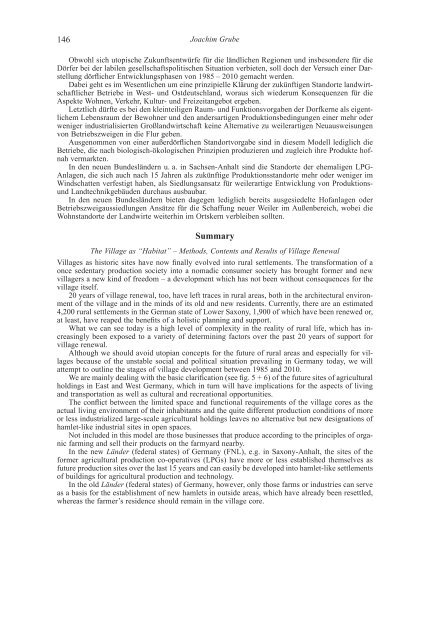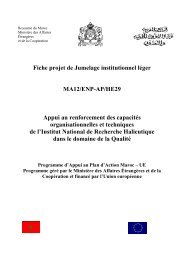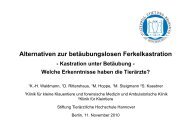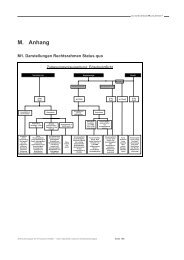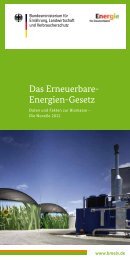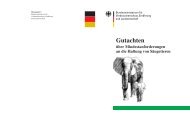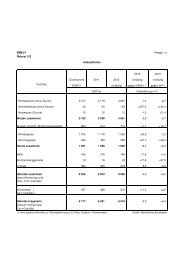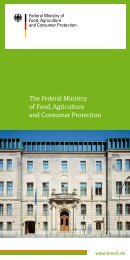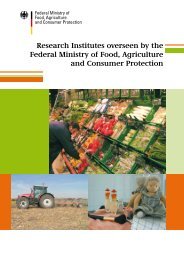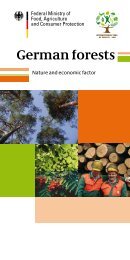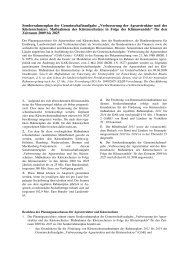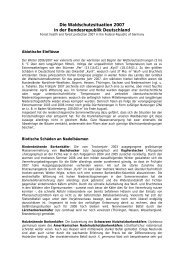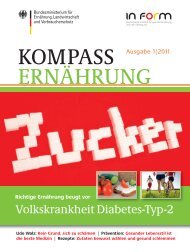Berichte über Landwirtschaft - BMELV
Berichte über Landwirtschaft - BMELV
Berichte über Landwirtschaft - BMELV
Erfolgreiche ePaper selbst erstellen
Machen Sie aus Ihren PDF Publikationen ein blätterbares Flipbook mit unserer einzigartigen Google optimierten e-Paper Software.
146 Joachim Grube<br />
Obwohl sich utopische Zukunftsentwürfe für die ländlichen Regionen und insbesondere für die<br />
Dörfer bei der labilen gesellschaftspolitischen Situation verbieten, soll doch der Versuch einer Darstellung<br />
dörflicher Entwicklungsphasen von 1985 – 2010 gemacht werden.<br />
Dabei geht es im Wesentlichen um eine prinzipielle Klärung der zukünftigen Standorte landwirtschaftlicher<br />
Betriebe in West- und Ostdeutschland, woraus sich wiederum Konsequenzen für die<br />
Aspekte Wohnen, Verkehr, Kultur- und Freizeitangebot ergeben.<br />
Letztlich dürfte es bei den kleinteiligen Raum- und Funktionsvorgaben der Dorfkerne als eigentlichem<br />
Lebensraum der Bewohner und den andersartigen Produktionsbedingungen einer mehr oder<br />
weniger industrialisierten Großlandwirtschaft keine Alternative zu weilerartigen Neuausweisungen<br />
von Betriebszweigen in die Flur geben.<br />
Ausgenommen von einer außerdörflichen Standortvorgabe sind in diesem Modell lediglich die<br />
Betriebe, die nach biologisch-ökologischen Prinzipien produzieren und zugleich ihre Produkte hofnah<br />
vermarkten.<br />
In den neuen Bundesländern u. a. in Sachsen-Anhalt sind die Standorte der ehemaligen LPG-<br />
Anlagen, die sich auch nach 15 Jahren als zukünftige Produktionsstandorte mehr oder weniger im<br />
Windschatten verfestigt haben, als Siedlungsansatz für weilerartige Entwicklung von Produktions-<br />
und Landtechnikgebäuden durchaus ausbaubar.<br />
In den neuen Bundesländern bieten dagegen lediglich bereits ausgesiedelte Hofanlagen oder<br />
Betriebszweigaussiedlungen Ansätze für die Schaffung neuer Weiler im Außenbereich, wobei die<br />
Wohnstandorte der Landwirte weiterhin im Ortskern verbleiben sollten.<br />
Summary<br />
The Village as “Habitat” – Methods, Contents and Results of Village Renewal<br />
Villages as historic sites have now finally evolved into rural settlements. The transformation of a<br />
once sedentary production society into a nomadic consumer society has brought former and new<br />
villagers a new kind of freedom – a development which has not been without consequences for the<br />
village itself.<br />
20 years of village renewal, too, have left traces in rural areas, both in the architectural environment<br />
of the village and in the minds of its old and new residents. Currently, there are an estimated<br />
4,200 rural settlements in the German state of Lower Saxony, 1,900 of which have been renewed or,<br />
at least, have reaped the benefits of a holistic planning and support.<br />
What we can see today is a high level of complexity in the reality of rural life, which has increasingly<br />
been exposed to a variety of determining factors over the past 20 years of support for<br />
village renewal.<br />
Although we should avoid utopian concepts for the future of rural areas and especially for villages<br />
because of the unstable social and political situation prevailing in Germany today, we will<br />
attempt to outline the stages of village development between 1985 and 2010.<br />
We are mainly dealing with the basic clarification (see fig. 5 + 6) of the future sites of agricultural<br />
holdings in East and West Germany, which in turn will have implications for the aspects of living<br />
and transportation as well as cultural and recreational opportunities.<br />
The conflict between the limited space and functional requirements of the village cores as the<br />
actual living environment of their inhabitants and the quite different production conditions of more<br />
or less industrialized large-scale agricultural holdings leaves no alternative but new designations of<br />
hamlet-like industrial sites in open spaces.<br />
Not included in this model are those businesses that produce according to the principles of organic<br />
farming and sell their products on the farmyard nearby.<br />
In the new Länder (federal states) of Germany (FNL), e.g. in Saxony-Anhalt, the sites of the<br />
former agricultural production co-operatives (LPGs) have more or less established themselves as<br />
future production sites over the last 15 years and can easily be developed into hamlet-like settlements<br />
of buildings for agricultural production and technology.<br />
In the old Länder (federal states) of Germany, however, only those farms or industries can serve<br />
as a basis for the establishment of new hamlets in outside areas, which have already been resettled,<br />
whereas the farmer’s residence should remain in the village core.


